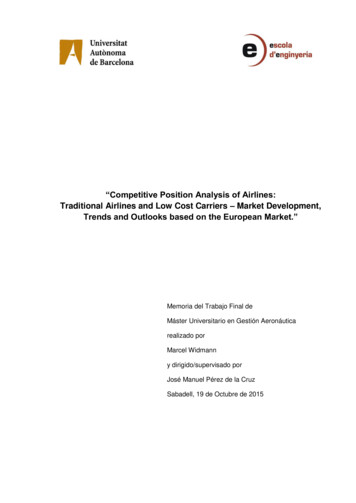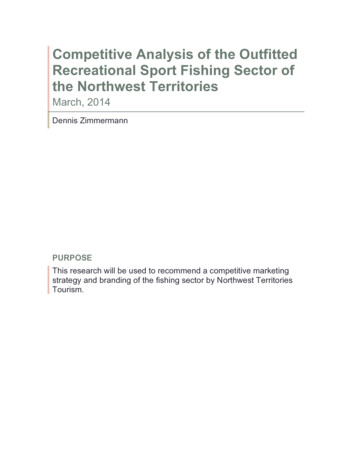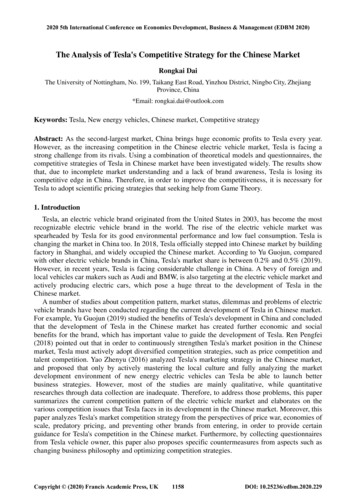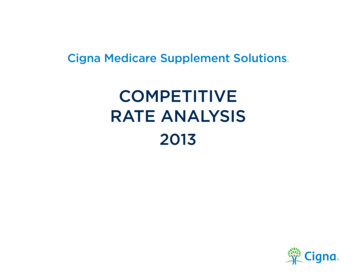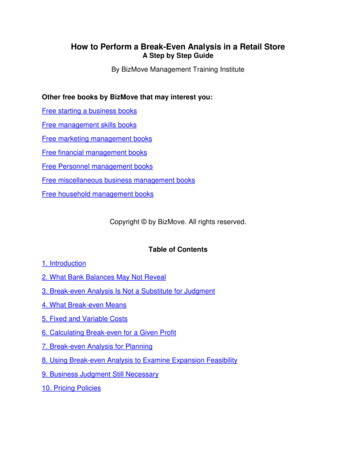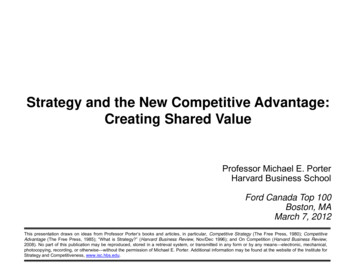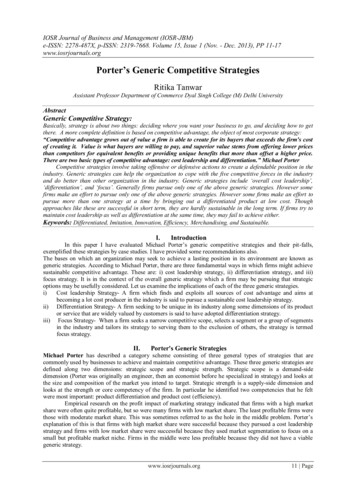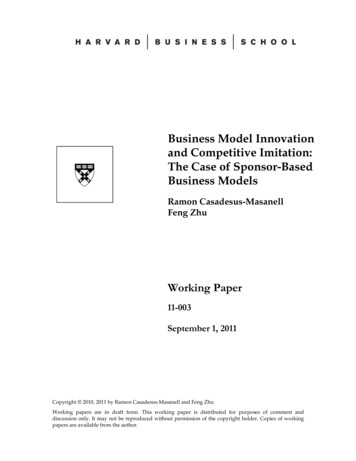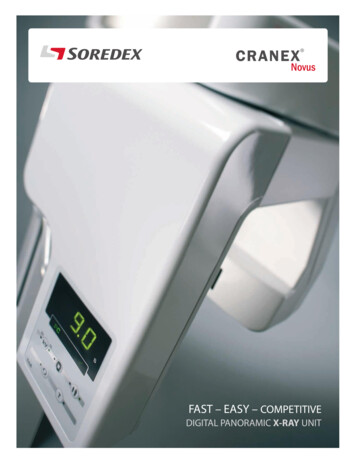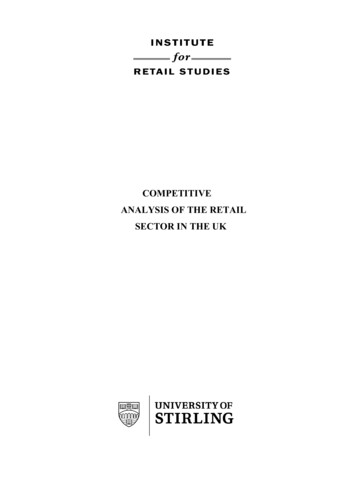
Transcription
COMPETITIVEANALYSIS OF THE RETAILSECTOR IN THE UK
DEPARTMENT OF TRADE AND INDUSTRY:COMPETITIVE ANALYSIS OF THE RETAILSECTOR IN THE UKReport submitted toThe Department of Trade and Industry (Tender CGS/1239)Professors Steve Burt and Leigh SparksInstitute for Retail StudiesUniversity of StirlingStirling FK9 4LAScotland, UKPhone: 44 (0)1786 467386Fax: 44 (0)1786 465290E-Mail: s.l.burt@stir.ac.uk ; Leigh.Sparks@stir.ac.ukRevised for Seminar - January 2003
DEPARTMENT OF TRADE AND INDUSTRY: COMPETITIVEANALYSIS OF THE RETAIL SECTOR IN THE UKContents0Executive SummaryIBackground and Framework for AnalysisIICompetitive Analysis – the UK Retail SectorIIISummary and Policy RecommendationsIVAppendix – Analysis of Retail Sub-Sectors
EXECUTIVE SUMMARY0.1Background and Framework for AnalysisIn early 2002 the Institute for Retail Studies at the University of Stirling wascommissioned to carry out a ‘Competitive Analysis of the Retail Sector in the UK’(tender CGS/1239) based on secondary sources and restricted to the UK rather thaninternational comparisons.The project had three objectives:· to define and map the sector in terms of size and composition of the businesseswhich operate within it;· to analyse the competitiveness of the sector now through SWOT, PEST andPorter's 5 forces and any other appropriate means and summarise the key issuesfacing the sector as a whole, and also sub-sector specific issues;· to provide recommendations for industry and government.The report is divided into four parts. In Part I we provide a background to the sectorand explain the framework for analysis used in the study. Part II provides thecompetitive analysis of the whole (generic) retail sector based upon the threecomponents of the framework: drivers for change; sector structure; and internalcharacteristics and competencies. Part III summarises the report and providesrecommendations based upon our interpretation of the analysis. Part IV, presented asan appendix, provides a series of sub-sector analyses for the nine retail sub-sectorsidentified by the DTI.Retailing is one of the major economic sectors of the country, with retail sales of 221billion, employing around 3 million people and operating over 300,000 shops. Withinthe sector there is a scale polarisation at both the business and the store level. Theleading retailers are huge, multinational businesses which dominate the sector. Theyoperate a range of stores from major hypermarkets and supercentres through to smallconvenience stores.Retailing is also significant it its social dimension as well. Whilst economicallyretailing bridges production and consumption, in social terms it effects most of thepopulation every day. It is the rare person who does not go shopping, or indeed hasnot worked in retailing or been involved in it in some way. For some, retailers offertheir major social intercourse of the day or week and act as a social network, settingor centre. The quality of UK retailing and its locations thus has both an economic anda social bearing on the perceptions of the country.What we term retailing is however changing, both in horizontal and vertical terms.Traditional product boundaries have altered and strict lines of business havedissolved. Retailers have also extended their tasks to encompass the supply chain andintermediaries and suppliers are effectively managed and controlled by the retailers’channel dominance.Institute for Retail Studies – Competitive Analysis of the Retail Sector in the UK2
0.2Competitive AnalysisRetailing is the subject of a number of drivers of change, which affects theenvironment within which retailing operates. The overall effect of these drivers onretailing can be broadly summed up as concentration, price and cost pressures andcomplication. Concentration emerges in the sense of business concentration as thelarger retailers continue to develop and the country engages more fully in the globalretail economy. Concentration also emerges in the focus upon certain key retaillocations ie. spatial concentration, driven by restrictive land-use planning and a desirefor high quality and compact locations. Price and cost pressures are inevitable giventhe operating parameters of retailing and their need for a variety of inputs. Beingefficient in use and operation is one response, but seeking out the best sources ofsupply is another. Complication arrives from the fragmentation of consumers andtheir volatility. This in turn adds to pressures on retailers to be rapidly responsive.These drivers for change will impact, and have impacted on, the sector structure. Theretail sector can perhaps be summarised as expanding, polarised, innovative and open.The sector itself is expanding in both horizontal and vertical dimensions as retailerstake on more activities and develop broader strategies. As these are successful, sopolarisation in the sector increases as the biggest companies continue to grow in scaleand as they operate a larger range of store types. Innovation has thus been critical todevelopment and has occurred at the store format, operations, products and brandinglevels. Finally, the UK market is open, allowing overseas retailers easy entry and thusraising competition. UK retailers have thus begun to expand overseas to seek out newmarkets and to exploit advantages.The methods by which retailing is carried out and the activities undertaken are alsochanged by the drivers for change and the altered scope of retailing. Retailers havebecome very good at managing aspects of their business and developing theirsystems, approaches and practices. They have done this in terms of their ownoperations, outsourced or partnered activities and by exploiting their scale, data andreach. However, this process has perhaps made them less ‘likeable’ just as their needfor high quality labour has expanded. As a consequence, the industry perhaps needsto re-engage with people and their desires in order to better promote the sector as aplace to work. Too often the perceptions of the retail industry from outside are poor.0.3RecommendationsBased on our analysis and the wider reading undertaken as part of this project wemake a number of recommendations to assist the future development of the retailsector:1. Retailing needs to be accorded a higher status within government departments inrecognition of its significance. Government should seek to grant retail similarstatus to other sectors of the economy;Institute for Retail Studies – Competitive Analysis of the Retail Sector in the UK3
2. There is conflicting evidence about accessibility to retail outlets and researchshould be brought forward by ESRC/DLTR to investigate fully the dimensions ofaccessibility;3. Competitiveness in British retailing will not be promoted by restrictions onmerger and development. A looser regime on amalgamation may provide a moreappropriate competitive sector, provided it is balanced with consumer interestissues;4. Issues of accessibility should be considered before any major de-regulation ofplanning is contemplated. A full study of the negative externalities of deregulation is a vital pre-requisite to such a policy;5. Government should investigate how best to enhance the skill set of smallerretailers in terms of supply chains and other practices;6. Government should examine and argue for the opening of markets to Britishcompanies, attempting to reduce barriers to entry and takeover;7. Research should be commissioned into the capabilities and competencies ofmatched UK and non-UK retailers as regards their ability and reaction in nonhome market operations;8. The retail sector should together, in an equal partnership with education at alllevels, seek to provide a true seamless retail skills ladder and be prepared to fundstaff and programmes;9. A full review of the costs of compliance with legislation by large and smallretailers should be undertaken;10. Retail organisations would benefit from being more inclusive and from closercollaboration or even amalgamation;11. Local authorities and other support agencies need to investigate how best to helpsmaller retailers at both the local level and nationally;12. ONS should undertake an urgent review of the quality and quantity of retail dataproduced officially, whilst the retail sector should identify issue based data needswhich would enhance the understanding of the sector.Institute for Retail Studies – Competitive Analysis of the Retail Sector in the UK4
PART IBACKGROUND AND FRAMEWORK FOR ANALYSIS1. IntroductionThe terms of reference for this report are laid out in the Department of Trade andIndustry tender CGS/1239 “Competitive Analysis of the Retail Sector in the UK” andthe subsequent response from the Institute for Retail Studies, University of Stirling,dated January 2002.The aim of the project is to produce a competitive analysis of the Retail Sector (andits main sub-sectors) in the UK. This exercise will allow consideration of howretailing contributes to UK competitiveness now, how this might change in the futureand what needs to be done to maximise the potential of the sector for the long-termbenefit of retailers, suppliers and customers.In meeting this aim, the project has (according to the invitation to tender) threeobjectives:·to define and map the sector in terms of size and composition of the businesseswhich operate within it;·to analyse the competitiveness of the sector now through SWOT, PEST andPorter's 5 forces and any other appropriate means and summarise the key issuesfacing the sector as a whole, and also sub-sector specific issues;·to provide recommendations for industry and government.The invitation to tender indicated that the research method should be secondary innature, and that the scope was the UK rather than international comparisons.2. Analysing the UK Retail Sector – Scale and ScopeRetailing is a crucial sector and major contributor to the UK economy, as table 1shows. At a simple level, for the majority of consumer goods and services it providesthe link between production and consumption. All of us shop and many have weeklyif not daily contact with some form of retailing. The sector is also a significantemployer, particularly in the youth and female segments of the labour force.Furthermore beyond the large omnipresent chains, exists a large body of independentbusinesses, which provide self-employment opportunities.Institute for Retail Studies – Competitive Analysis of the Retail Sector in the UK5
Table 1 : Retailing in the UK Economy, 2000Retail SectorWholeEconomy*1 735 3861 960 68624 693606 228as % of WholeEconomy12.411.212.48.1Number of Enterprises215 373Turnover m (exc VAT)218 936Total Employment ‘0003 050Approximate Gross Added Value49 275at basic prices m* whole economy defined as SIC sections C-O – Production, Construction,Distribution and Services (excludes Agriculture, Forestry and Fisheries etc)Source : ONS Annual Business InquiryDespite its significance, identifying the dimensions of the overall retail sector is quitedifficult. Official government statistics in the sector are poor and inadequate and thecommercial providers often struggle to produce meaningful comprehensive data.Often data sets purporting to measure the same thing do not tally. The most recentRetail Inquiry for example does not even contain an estimate of the number of shopsin the country. In general terms, broad identifiable scale parameters include:·Retailing has sales of 221 billion (current prices);·It is comprised of over 215,000 businesses operating somewhat over 310,000shops;·Between 2.8 and 3 million people work in the sector which additionally contains afurther 300,000 self-employed people.Within this sector there are many dichotomies. The size of business variesenormously from some of the largest in the country (Tesco with sales of over 22.7billion) and components of the world’s largest business (Wal-Mart) to the local cornershop or even car boot sale stall-holder. A single shop could employ many thousandsof staff (Harrods) or could be a one-person enterprise. Many staff are paid at theminimum wage for a few hours work, whereas owner-directors such as Philip Greencan take in over 100 million for turning around BHS, or even ‘normal’ directors suchas seven of the current Tesco board can earn over 1 million per year.For such a crucial sector of the economy detailed mapping of the sector is also farfrom easy. Analyses are traditionally conducted on product or store format basedtypologies eg the food retailing sector, or superstore sector or convenience storesector. Official data, produced by ONS, essentially follow a “line of trade” typology,and this approach pervades most of the reviews of the sector produced by consultancyand market research agencies. Although driven by the confines of data collection andpresentation, any analysis of the sector should recognise that there is now afundamental blurring of the “retail sector” in both horizontal (eg product line) andvertical (eg channel activity) dimensions.With respect to the horizontal characteristics of the retail sector, as businesses havesought to grow and the physical size of outlet has expanded, traditional productboundaries have dissolved. Food retailers now no longer merely sell fresh and dryInstitute for Retail Studies – Competitive Analysis of the Retail Sector in the UK6
groceries but also retail electrical products, financial services, clothing andentertainment products (CDs, Videos, newspapers, toys). The boundaries oftraditional “hardware” retailing now encompass garden products, furniture, and homefurnishings. The widening of consumer demand and changing consumerexpectations, increased sophistication of stock control and management informationsystems, plus the appearance of new product markets (eg mobile telecommunications)all involve pressures which have encouraged retailers to think and operate “outside”the traditional retail product boxes.Change in the vertical dimension of the retail
DEPARTMENT OF TRADE AND INDUSTRY: COMPETITIVE ANALYSIS OF THE RETAIL SECTOR IN THE UK Report submitted to The Department of Trade and Industry (Tender CGS/1239) Professors Steve Burt and Leigh Sparks Institute for Retail Studies University of Stirling Stirling FK9 4LA Scotland, UK Phone: 44 (0)1786 467386 Fax: 44 (0)1786 465290 E-Mail: s.l.burt@stir.ac.uk;
